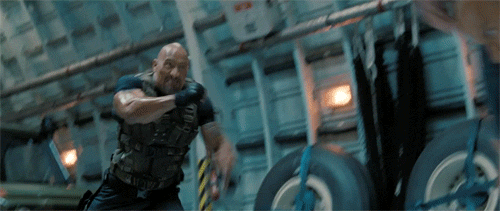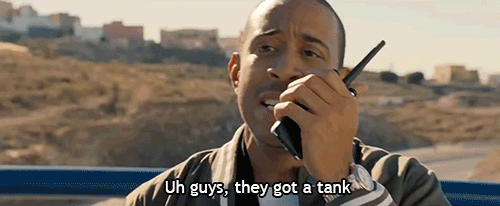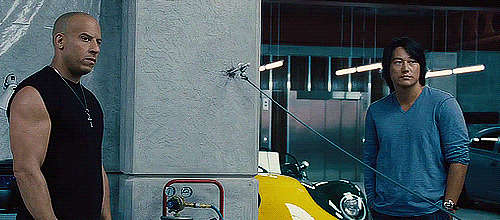
Forget Pain & Gain: Fast & Furious 6 is this year's true meathead American dream movie. Both are crudely written love letters to self-determination, getting ahead, and good ol’ fashioned bootstrap-pulling, adding a touch of blue collar to a summer blockbuster season dominated by superheroes, and space cadets. Their heroes are plucky, lower-middle class survivors who don’t wait for a shot at success, but brute force one into existence through rejection of society, and its laws. The films luxuriate in orgiastic lifestyle porn, riding high on wealth cultivated from a separate outlaw fantasy of Robin Hood-esque adventure, stealing, shooting, and violently elbowing a place into the ranks of the 1%. These are the champions of a 9-to-5er’s daydreams, getting rich quick, while valiantly flying a middle finger to the corporate power abusers, and corrupt bureaucracy that creates the real world’s millionaires.

Fast one-ups Pain though, as the now sextet of wildly successful automotive-focused action movies are themselves proof of free market economics leading to better consumer products. The first three entries are, in retrospect, experimental prototypes, following different hypothesis of what 21st century audiences want from four wheel action flicks, with the surprise success of Fast and Furious (the fourth instalment) being the first of many eureka moments. With each film in the now decade-spanning franchise, the tone and cast have been honed to a finer blade, one that continues to slice through demographic barriers, and financial milestones. Fast Five was another major turning point for the series, reorienting the action away from neon-lit underground street race culture, and toward a more accessible genre of heist films -all to the tune of $600 million worldwide, and newfound critical praise.
A great deal of that success came from cherry-picking cast members and content from the original trilogy, with The Fast and Furious, 2 Fast 2 Furious, and The Fast and the Furious: Tokyo Drift serving as try-outs for what/who would become the real stars for the series. The franchise now operates at a level where Vin Diesel being the one to growl out tough guy talk is as important to opening day as Robert Downey Jr. being in the Iron Man suit (as if aware, Fast 6 has three separate instances wherein the same character is compared to one of Marvel’s Avengers). Showing Stallone’s dinosaur herd how it’s really done, the Fast films have sucked up more and more A-list-of-the-B-list talent with each instalment, and benefited greatly for it. Dwayne “The Rock” Johnson was a smashing addition last time, and MMA-fighter/surprisingly-capabale-actress Gina Carrano joins the ranks in 6, an intimidating warm-up act for the already announced headliner joining the also already announced part seven.

The Fast films continue to grow in popularity, as what little esoteric flavor there was in the first few films has been flattened and smoothed out so thoroughly, that it’s not just a stereotypical frat boy audience that's getting excited for each new lap around the familiar track. The expanding list of players has brute-forced personal, high-stakes drama into a roster of characters previously defined the by just the label of cop or crook. Viewers are now coming to these movies for the characters behind the wheels, not just the wheels themselves, and with every entry, the franchise has become even more of a creatine-infused bro-out with values like loyalty, and friendship -not just cars, beer, and firearms. The once struggling enterprise has course corrected itself toward achievements greater than ever, but even as its star rises to increasing box office heights, its heart still remains firmly at home. After all the testosterone-fuelled pyrotechnics, 6 ends in hand-clasped prayer amongst a family, all giving thanks for the comfort of home, financial security, and, of course, fast cars. It ain’t Capra, but if that’s not the American dream of the modern era, what is? It's a question that might fill your head when watching a blockbuster action movie as mind-numbingly boring as Fast 6 can be at times.
Here’s where I stand with the franchise: I’ve seen enough clips, and channel-surfed through enough of the first four films to make up maybe a movie and a half, but like many others, Fast Five was my introduction proper to Dom, Han, and whatever Paul Walker’s character’s name is. And it blew my socks off. Fast Five is a two-hour clinic of propulsive action, and efficient storytelling that's nigh impossible to not fall in love with. It straddled the line of “so bad its good,” and “legitimately great” so deftly, moments appealing to my Neanderthal, lizard hindbrain, and the rest of my mind that appreciates good movies, were nearly inseparable. Even if the film’s closing tease of a returning character meant nothing to me, I was in for Fast and Furious 6 already, because, holy shit, I just watched a bank vault get slingshot around downtown Rio de Janeiro like an oversized can dangling behind a car reading “Just Married To This Franchise.”
And sure enough, I vowed to see the next entry back in those halcyon days of 2011, but now stand before you a man sadly underwhelmed. Sure, I guess for pure spectacle, 6 has a lot going for it. It’s no vault heist, but a vehicular fight to the death between a bunch of cars and a cargo plane can't be ignored. Going further over the top than even Fast Five, 6 isn’t just divorced from reality, but sets out to burn every photo album and mixtape it still had as evidence it was ever in a relationship with things like restraint, subtlety, and physics. The characters are now able to withstand Looney Toons levels of physical punishment, and the finale takes place on a never-ending runway that might as well be a looping cartoon background. It’s gonzo spectacle of a high-calibre; hell, its climax might be the most expensive piece of innuendo in movie history. Look at this gif, and tell me there isn’t something INCREDIBLY Freudian going on here:

But while 6 still brings plenty of crazy to the table, the slower bits holding all the destruction together are a far more sluggish affair this time out. The balance of snarky enjoyment to authentic, rapt awe I experienced with Five was near perfect, while 6 pushes things far more in the direction of the former. The dialogue has lost much of its cheesy charm, and just become dull, overdoing it on the self-satisfied, “look how cool we are” non-sequiturs, and platitudes about what in means to be in “the life” of an underground racer/illicit millionaire/alpha-bro. Meanwhile, the more the film tried to earnestly lean into the familial relationships, the more I found myself tuning out, seeing as the only distinguishing feature among each character is which kind of car they like, and what stock role they fill.
Playing completely into Universal’s hands, I’m more interested in the actors than the character’s they’re playing, especially as someone with no reverence for the Fast “mythology.” Paul Walker is every fiber the bland, affectless pretty boy you would expect of a Paul Walker character, barely registering in just about every scene he’s in. Vin Diesel does his usual “muffler caught in the windpipe” tough guy shtick, and really looks like he could use a nap more than anything. The supporting cast gets it done though, chief among them being Dwayne Johnson, who remains America’s most unexpectedly charismatic leading man. His stare-downs with Diesel work on so many levels, at once pushing the undercurrent in "homoerotic undercurrent" to its breaking point, while also providing an interesting directorial challenge, as cutting between the two requires each to look more bulked-up and threatening than the other. And it’s also just really funny to see the nape of each chrome dome’s neck bunch up like an accordion, as though their head’s might spring up at any moment like a jack-in-the-box.

Again though, the problem is that there’s too much ironic enjoyment being had, not honest fun. The humor continues to be almost entirely miss, relying on more of the usual thunderously stupid innuendo and frat house ball-busting. The slobs vs. snobs subtext doesn’t have any juice anymore, seeing as all the characters are now multi-millionaires, so when one of them spends a good two minutes of screentime humiliating a snooty English car dealer, it’s kinda cruel, in addition to being completely unnecessary. The funniest thing about the films continues to be how the third entry, which takes place after all the others -despite being set in 2006-, continues to be an albatross around the franchise’s neck. I’m certain someone will write a brilliant film school thesis on how the continued foreshadowing of Han’s approaching death in Tokyo Drift is secretly the great action movie existential drama of the 21st century.
But really, all would be forgiven if the setpieces were firing on all cylinders, but Fast Five once more proves to be the superior experience. Justin Lin is a really talented director of fight scenes (the brawls in the London underground are pretty stellar), but even by his fourth Fast, still hasn’t figured out how to make the driving sequences work consistently. By providence, I saw a bit of #4 last night, and marvelled at how awful and intrusive a GPS computer providing logistical commentary on a race was, something Fast Five didn’t bother with by having open, brightly lit, and clearly established racetracks. Spatial context is still all but impossible to establish at 100 miles an hour, but it’s a problem 6 exacerbates with constant quick-cutting to gears being shifted, and speedometer needles spiking, instead of establishing shots. The real shame is that three of the four big driving sequences are set at night, resulting in blurry messes that feel like “follow the light” eye exams, rather than well-photographed showstoppers.
Most disappointing though, are the hints that the series will be returning to its roots for Fastest & Furiousest 7: The Fastening, or whatever the hell Universal decides to call it (the actual title card for this one reads Furious 6). The best gag in Five sets up an epic street race, but cuts to its inevitable conclusion immediately, because there is not one person in the audience who doesn't already know that Vin and company are going to win. Six brings the racing back, but unless you’re really invested in Diesel and Michelle Rodriguez’s relationship, it’s just another banal as fuck car chase with no stakes or flair, which we can probably expect more of with Seven’s return to L.A., and the departure of Lin.
Where Fast Five looked the start of a beautiful friendship, the new in-film metaphor of choice comes from seeing that cargo plane tethered down by a half-dozen cars, trying to lift off, but weighed down by old baggage. I won’t call this an official review, but I’ll just say that Fast 6 is already my frontrunner for most disappointing film of summer 2013. It’s still enjoyable in spots (the tank sequence is just unhealthy levels of stupid, human-life-disregarding fun), but Fast & Furious 6 just can’t keep pace with the finely tuned bliss of Fast Five.
Oh wait, they’re bringing him into the franchise next time? Sigh. Fuck you Universal, you’ve got me for at least one more movie. Please make it count.


